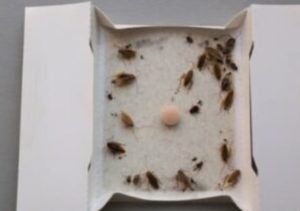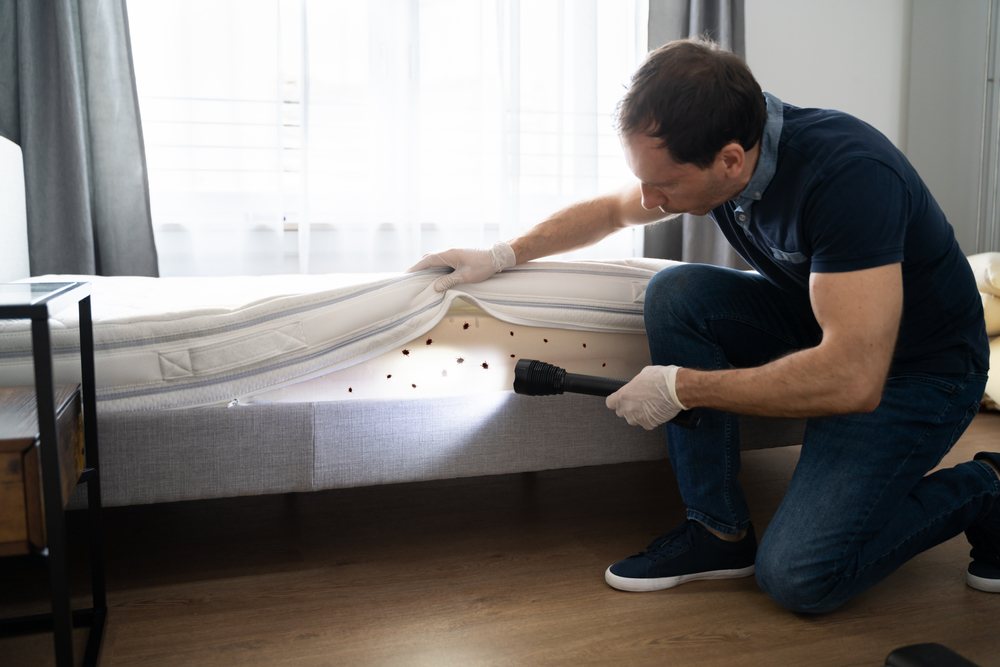We’ve all been there. When you come across a series of bites on your skin or small red flecks on your sheets and you just know… it’s bed bugs.
You start to wonder.
What exactly is a bed bug?
How long do these things live?
What do they eat for food?
Here’s the thing…
Bed bugs are actually interesting little creatures.
They can survive almost any condition, including starvation, and have the ability to spread fast.
But, don’t take my word for it, let’s jump right in!
Here’s everything you need to know about the bed bug life cycle so that you can get ahead of your budding infestation.
Page Contents:
How Many Stages are in the Bed Bug Life Cycle?
Bed bugs start off as small eggs, just 1 mm in length.
These small white specks can be difficult to see with the naked eye.

In fact, they’re nearly invisible on light-colored surfaces like cloth sheets and mattresses covers.
Their eggs have a sticky coating that allows them to attach easily to bedsheets, mattresses, and even the fur of your household pets!
That means they can travel all around your house before you realize you have an infestation.
At room temperature, a bed bug egg takes about 1 week to hatch.
Once the egg hatches, a bed bug nymph is born.
(Yep, that’s “nymph”, spelled just like the water fairies in children’s books).
Bed bugs will remain in the nymph phase for 5 rounds of molting.
Each time they molt, they shed their old shell and a new one hardens. Eventually, they achieve their adult size of about 5.5 mm.
So for those running a count, there are 3 main phases of the bed bug life cycle:
- Egg
- Nymph
- Adult
But, don’t be fooled.
Nymphs (baby bed bugs) aren’t harmless creatures.
In fact, they are just as likely to bite you as their adult counterparts, so don’t let their small size mislead you.
How Long is the Bed Bug Life Cycle?
The bed bug life cycle consists of 5 rounds of molting from the time a baby bed bug grows into an adult.

Each time…
The molting phase begins by the bed bug chowing down on a hearty meal of human blood.
Then, for 10 days it grows larger until it sheds its shell like a snail or crab.
It takes about 50 to 60 days for a baby bed bug to reach sexual maturity at which point it will begin to lay eggs of its own.
Finally, the bed bug will die of natural causes within a few months.
(Depending on the surrounding conditions).
What is Their Lifespan?
After the fifth round of molting, an adult bed beg has achieved its full size and will live on average about 6 to 12 months.
Of course…. that’s in laboratory conditions.
(A highly controlled environment).
In the real world, bed bugs usually live much shorter lifespans. There are several factors that contribute to this.
It seems they do better when:
- They live in cooler climates
- They have an abundant food source
- These insects are surrounded by stable environmental conditions
That may be why the eastern United States contains many of the worst states for bed bugs.

Pictures of the Bed Bug Life Cycle
The video below shows the bed bug life cycle in detail.
During this creature’s lifetime, it will go through these stages of development (from left to right).
In general, bed bugs have the following characteristics:
- About ¼ inch in size.
- Long and brown, with a flat shaped body (if not fed recently).
- Balloon like and rounded, reddish-brown and elongated (if fed recently).
- They contain a beak with 3 segments, and antennas.
- They have a musty odor (coming from glands that produce histamine).
Below is an image of what a bed bug bite looks like up close.

Young bed bugs generally have the following characteristics:
- About 1/12 inch in size.
- Translucent (white yellowish color).
- Can sometimes be invisible to the naked eye.
Do Bed Bugs Start Out As Larvae
After bed bugs hatch, they are referred to as bed bug larvae.
Although bed bugs are small, their larvae are much smaller.
These creatures look like a single grain of sand, and you can only see them with a microscope.

Larvae do bite and feed, so if you are covered in bites, it’s likely you were bitten by bed bugs in different stages of life.
If you cannot find any adult bed bugs around, it’s likely that larvae may have migrated to your bedroom from a neighboring infestation.
Baby bed bugs can fit into extremely small places, so they can crawl through the walls and infest you through a neighboring apartment or hotel room.
What is the Bed Bug Life Cycle Without Food?
Bed bugs need a source of food to grow big and strong… just like humans.
But, just because your house sits empty and dormant for a period of time, doesn’t mean you’ll be able to kick your infestation.
Bed bugs can actually live without food for a remarkable amount of time.
In fact, in a lab setting, some adults have survived without food at low temperatures for more than 400 days.
Nymphs, on the other hand, have a much harder time without food since they are smaller and weaker than adults.
For a nymph to grow well, it should feed at least once a week.
That way, they can begin to molt into their next stage and reach sexual maturity.
When a bed bug doesn’t have food, it will begin to enter a hibernation-like state.

In this phase, bed bugs develop a “hunger bubble” in their gut to fend off starvation. The hunger bubble helps bed bugs survive, particularly the larger ones.
Smaller nymphs will starve about 50% faster than their adult counterparts.
How Long Does it Take For Bed Bugs to Hatch?
Bed bug eggs will typically hatch in 6 to 10 days after the female lays them. Once hatched, the newly emerged baby bed bugs will look to feed immediately. Young nymphs can survive a few weeks without feeding but will need multiple blood meals to evolve into the different life stages.
Mature bed bugs can survive longer without feeding.
(up to 18 months if the conditions are right).
In most cases, bed bugs will live anywhere from 2 to 4 months long.
If you come across an infestation with bed bugs in multiple generations (eggs, nymphs, adults), then it’s pretty clear you have a severe infestation on your hands.
In a seasoned reproducing population bed bugs of all ages can be found and seen by the naked eye.
You should be aware that compared with other insects…
Bed bugs are actually slower to reproduce.
Adult females can produce up to 6 eggs per day. To put that into perspective, the common housefly lays 500 eggs over 3 to 4 days.
Each bed bug will take 5 to 6 weeks to grow into an adult as long as the creatures have a consistent source of food.
How Long Can Bed Bugs Live In….?
Let’s look at how long bed bugs live under certain environments.
How Long Do Bed Bugs Live in Cold?
Depending on the climate, bed bugs can survive for long periods of time when the temperature drops.
These creatures are cold blooded, so if they’re in a particularly cold climate (below 55 degrees F), bed bugs will go into a hibernation phase….

Allowing them to survive up to 1 year.
This is because the cold state slows down their metabolism allowing them to conserve energy until the conditions are better suited for feeding.
How Long Do Bed Bugs Live in a Plastic Bag?
Bed bugs will survive in a plastic bag just like any other environment where there is little access to food. Sealed bags are a good way to isolate bed bugs, but it will not suffocate them.
Bed bugs can survive at oxygen levels below 1% and even a sealed bag can let in enough oxygen to keep bed bugs from dying.
So what you’re essentially doing here is just cutting off their food source.
How Long Do Bed Bugs Live in An Empty House?
This answer will be similar to a plastic bag, as it has to do with starving bed bugs. Certain conditions will elongate the time in which bed bugs die from starvation, but in general these are fairly resilient creatures.

Whether it be:
- Hibernating through the cold.
- Losing much of their weight.
- Battling heat waves.
These insects somehow manage to survive. These are some of the things that make bed bugs the hardest insect to kill according to exterminators.
How Long Do Bed Bugs Live After Spraying?
If your home is professionally sprayed with insecticide, any bugs that are hit by the spray directly should die within a 2 to 3 hours.
Although even in some of the most comprehensive applications…
Some bed bugs can survive. The chances are some degree of bed bugs, nymphs, or eggs will be missed during the initial application.
For this reason,…
It takes multiple applications to kill all bed bugs.
For eggs that are missed, they could remain dormant for up to 1 month.
If you’re interested in purchasing insecticide, check our complete guide on bed bug sprays.

What is the Gestation Period For Bed Bugs?
Now that you know how long it takes for a bed bug to grow to full size, you’re probably wondering about how long it will be before the next round hatches in your home.
Here’s the thing…
Bed bugs mate in a similar way to other bugs, turtles, and birds.
After mating, females lay oval eggs along cracks and crevices in your home.
Bed bugs can lay a startling 200-250 eggs during their lifespans.
Each egg gestates for about 6 to 10 days before hatching.
That means that bed bug infestations can spread at an alarming rate.
How Many Babies Do Bed Bugs Have?
Bed bugs only live for about a year, but during that time they can have a lot of babies.
Of the 200-250 eggs that they lay in their lifetime, a large percentage will eventually hatch.

Since bed bugs live, on average, about a year and an adult bed bug can have babies all of the time, the math works out to be about 5 -6 eggs per day per adult female.
That kind of reproduction rate makes getting rid of them hard.
That means that if you have an infestation of just 5 female bed bugs, you could see as many as 40 bed bugs within a week.
After that, the babies would have to mature through the nymph phase before they can reproduce themselves.
Summary (Infographic)

Take Legal Action After an Infestation
Now you know a bit more about the way an infestation can go from just one bug to a major problem.
It’s important that you take steps to protect your home from bed bugs before any cross your threshold in the first place.
But, sometimes someone else’s negligence lets them in your door.
If you have dealt with a bed bug infestation after spending time in a hotel or resort, or if you rent from a landlord who knowingly placed you in an infested unit, you may have a legal case.
Get in touch with us today to get connected with an attorney.





Do you have an office in Canada or is this only in United states